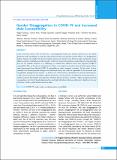Please use this identifier to cite or link to this item:
https://hdl.handle.net/20.500.14356/1244Full metadata record
| DC Field | Value | Language |
|---|---|---|
| dc.contributor.author | Acharya, Yogesh | - |
| dc.contributor.author | Pant, Suman | - |
| dc.contributor.author | Gyanwali, Pradip | - |
| dc.contributor.author | Dangal, Ganesh | - |
| dc.contributor.author | Karki, Priyanka | - |
| dc.contributor.author | Bista, Navindra Raj | - |
| dc.contributor.author | Tandan, Meera | - |
| dc.date.accessioned | 2023-05-03T08:37:32Z | - |
| dc.date.available | 2023-05-03T08:37:32Z | - |
| dc.date.issued | 2020 | - |
| dc.identifier.citation | AcharyaY., PantS., GyanwaliP., DangalG., KarkiP., BistaN. R., & TandanM. (2020). Gender Disaggregation in COVID-19 and Increased Male Susceptibility. Journal of Nepal Health Research Council, 18(3), 345-350. https://doi.org/10.33314/jnhrc.v18i3.3108 | en_US |
| dc.identifier.issn | JNHRC Print ISSN: 1727-5482; Online ISSN: 1999-6217 | - |
| dc.identifier.uri | http://103.69.126.140:8080/handle/20.500.14356/1244 | - |
| dc.description | Review Article | en_US |
| dc.description.abstract | Abstract Novel coronavirus disease 2019 (COVID-19) is a growing public health crisis. Despite initial focus on the elderly population with comorbidities, it seems that large studies from the worst affected countries follow a sex-disaggregation pattern. Analysis of available data showed marked variations in reported cases between males and females among different countries with higher mortality in males. At this early stage of the pandemic, medical datasets at the individual level are not available; therefore, it is challenging to conclude how different factors have impacted COVID-19 susceptibility. Thus, in the absence of patients’ level data, we attempted to provide a theoretical description of how other determinants have affected COVID-19 susceptibility in males compared to females. In this article, we have identified and discussed possible biological and behavioral factors that could be responsible for the increased male susceptibility. Biological factors include - an absence of X-chromosomes (a powerhouse for immune-related genes), a high level of testosterone that inhibits antibody production, and the presence of Angiotensin-converting enzyme 2 (ACE2) receptors that facilitate viral replication. Similarly, behavioral factors constitute - higher smoking and alcohol consumptions, low level of handwashing practices, and high-risk behavior like non-adherence to health services and reluctance to follow public health measures in males. Keywords: COVID-19; gender; males; sex disaggregation; susceptibility | en_US |
| dc.language.iso | en | en_US |
| dc.publisher | Nepal Health Research Council | en_US |
| dc.relation.ispartofseries | Jul-Sep 2020;3108 | - |
| dc.subject | COVID-19 | en_US |
| dc.subject | Gender | en_US |
| dc.subject | Males | en_US |
| dc.subject | Sex disaggregation | en_US |
| dc.subject | Susceptibility | en_US |
| dc.title | Gender Disaggregation in COVID-19 and Increased Male Susceptibility | en_US |
| dc.type | Journal Article | en_US |
| local.journal.category | Review Article | - |
| Appears in Collections: | Vol. 18 No. 3 (2020): Vol. 18 No. 3 Issue 48 Jul-Sep 2020 | |
Files in This Item:
| File | Description | Size | Format | |
|---|---|---|---|---|
| 3108-Manuscript-18823-1-10-20201115.pdf | Fulltext Article. | 220.95 kB | Adobe PDF |  View/Open |
Items in DSpace are protected by copyright, with all rights reserved, unless otherwise indicated.
